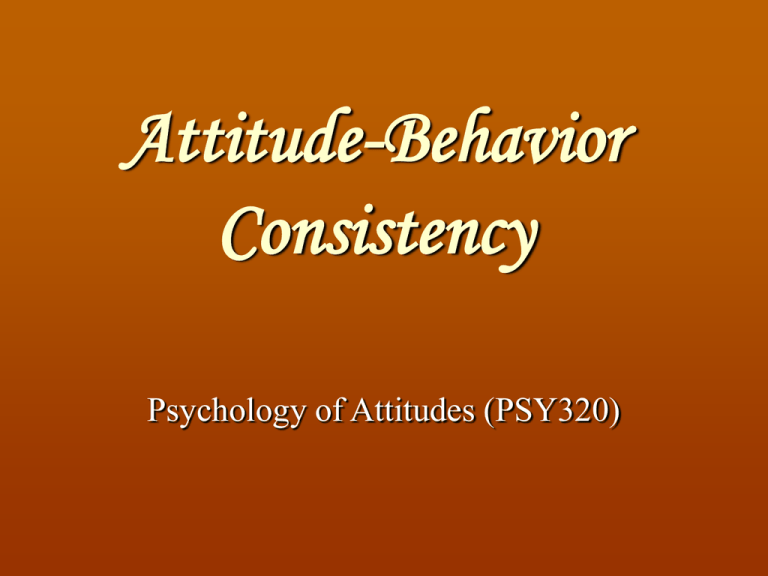
Attitude-Behavior
Consistency
Psychology of Attitudes (PSY320)
Outline
1. The Principle of Aggregation
2. The Theory of Reasoned Action
3. Theory of Planned behavior
4. Attitude Accessibility
5. Personality Influences
Outline
Lack of consistency in human affairs
LaPiere
Corey
Wicker's review
Psychometric Principle
Any single measure of behavior / psychological
construct (single-act criterion) is not reliable due to
the error associated with each single measure (e.g.,
she is an altruistic person, I need money therefore
she will lend me some).
SOLUTION?
Aggregation Principle
(e.g., she is an altruistic person, I need money will she
lend me money? This is the first time I asked her; I helped
her in the past numerous times; she just got a bonus pay at
work; therefore she will likely lend me the money).
Generality
The level of attitude-behavior consistency is related to
the level of generality of the constructs that are
correlated.
Attitudes are general and are measured in general terms
(positive or negative), while actions like ‘praying before
meals’ are very specific.
Therefore, we should measure attitude (i.e., general) by
looking at the general trend among many behaviors (i.e.,
aggregation).
Theory of Reasoned Action
Theory of Reasoned Action
The Theory of Reasoned Action is premised on the
belief that the immediate predictor of behavior is a
behavioral intention.
So what predicts behavioral intention?
Behavior: Buying erotic magazines
Attitude: includes salient beliefs/thoughts (‘it includes beautiful
models,’ ‘it makes me feel good’ ‘it make me imagine the good
times I will be having when I get married’)
1.
Belief (R)– if you buy an erotic magazine, what is the
probability of your salient beliefs coming true (expectancy)?
(range from +3 to –3)
2.
Evaluation (e)– how valuable is that salient belief to you?
(range from +3 to –3)
Attitude Toward behavior
Consequences
Exciting entertainment
Beautiful models
Is sexist
Funny jokes about sex
Belief (R)
+2
+3
+1
+1
Evaluation (e)
+3
+2
-3
+1
(R)(e)
+6
+6
-3
+1
+10
Total (Σ)
ATTITUDE = Σ(R)(e)
+10 is pretty high, but will the person buy the magazine?
It depends on the person’s subjective norms about the
behavior.
Subjective Norms About behavior
Important Referents
My girlfriend
My father
My neighbor
People in the store
(NB)
-2
-1
+3
-3
(MC)
+3
+1
+1
+2
Total (Σ)
(NB)(MC)
-6
-1
+3
-6
-10
SUBJECTIVE NORMS = Σ(NB)(MC)
NB – Normative beliefs (referents’ opinions on magazines?)
MC – Motivation to comply (how important is their approval?)
R
e
NB
MC
The Complete Model
Meta-Analysis Results
Attitudinal
Beliefs
.53
.62
.68
Normative
Beliefs
.53
Conclusion
Theory of Reasoned Actions shows that sometimes
attitudes fail in predicting / influencing behavior.
Social norms can trump attitude (i.e., exert a more
important influence on behavior).
The relative influence of attitudes and social norms is
influenced by situational and personality factors and
may vary across attitude objects.
The theory does not account for situations in which
people do not have control over their behavior (i.e.,
unable to carry out their intentions).
Theory of Planned Behavior
Theory of Planned behavior
Ajzen (1985; 1991) proposed a modification to
the Theory of Reasoned Actions.
He suggested that perceived behavioral control
influenced intention and behavior.
Theory of planned behavior
Specific attitudes are better predictors of
behavior than are general attitudes (Davidson
& Jaccard, 1979).
Subjective norms: People’s beliefs about
other’s view of the behavior in question.
Perceived behavioral control: Extent to which
people believe they can perform the behavior.
Theory of Planned Behavior
Beh. Beliefs
Attitudes
Evaluations
Intention
Norm. Beliefs
Subj. Norms
Compliance
Perceived
Beh. Control
Behavior
Conclusion
The Theory of Planned Behavior uses attitudes
towards behaviors to predict behavior, whereas
the original problem was to link attitudes
towards objects to behaviors.
The Theory of Planned Behavior neglects
some additional influences on behavior.
Automated behavior (habits) may reflect neither
attitudes nor social norms.
Predicting Spontaneous
Behavior
Accessibility Theory (Fazio)
Core Notion - Attitudes will predict behavior
if (and only if) they can be activated from
memory at the time of the decision.
Attitude must come spontaneously in the
situation
Attitude must influence perceptions of an issue
or person, serving as a “filter through which the
object is viewed”.
Accessibility Theory
According to Fazio’s model, all the information
about a specific subject is contained in one node.
The summary evaluation (i.e., attitude +/-) about the
subject is contained in another node, connected to
the subject node.
The strength of the association between the subject
node and the summary evaluation node determines
attitude accessibility.
Accessibility Theory
Weak association between the subject and the
summary evaluation→ attitude is inaccessible
and unlikely to influence behavior.
Instead, arbitrary aspects of the
situation/context will tend to determine
behavior.
Accessibility Theory
When attitudes are expressed many times, a
strong association develops between the
summary evaluation and the subject.
Strong association between the two nodes, then
spreading occurs quickly from one node to the
other (attitude is very accessible) → influence
behavior.
Response Latency
Response latency has been used as a measure
of accessibility – i.e., “How long does it take
for someone to provide an
answer/attitude...?”
Moderators of Attitudes/Behavior
Consistency
Three key variables which can moderate the
relation between attitudes and behavior:
1.
2.
3.
Qualities of the attitude (attitude factors/nature),
Aspects of the situation (situational factors)
Characteristics of the individual (personality
factors).
Qualities of Attitudes
Attitude Strength
Strong attitude are more likely to influence behavior
Ambivalence. People recognize positive and negative
aspects of an attitude object - can moderate the relation
between attitude and behavior.
High ambivalence: Behavior can be influenced by the
positive or the negative aspects (inconsistent).
Low ambivalence: Only positive or negative aspects are
activated (consistent).
Self-Monitoring
Self-monitoring is a personality variable
thought to influence behavior.
People who are high in self-monitoring behave
according to the situation (most likely behave
inconsistently).
People who are low in self-monitoring draw on
feelings and attitudes when behaving (behavior
is normally much more consistent across
situations).
Conclusion
Whether attitudes influence behaviors depends
on several factors.
Attitudes have a stronger effect when they are
activated by situational cues.
Attitudes have a stronger effect when people
are self-aware.
Consistent attitudes have a stronger effect on
behavior than ambivalent attitudes.
Are we consistent in our
attitudes?
LaPiere Road Trip (1930)
Trip with a Chinese couple through the USA – the
couple was refused service only once.
LaPiere wrote to the owners and asked them if they
would serve a Chinese couple at their establishment 90% of the replies said ‘NO.’
Results:
negative attitudes (questionnaire) and positive
behaviors (actually serving)!
Corey (1937)
Attitude-behavior consistency and cheating.
Objective: predict from the attitude survey
(your attitude towards cheating) who would
cheat
Results:
No correlation between attitude and behavior.
Wicker’s Review
Wicker (1969) reviewed all the studies on
attitude-behavior consistency.
Conclusion:
The relationship between attitudes and behavior
was very weak.
Psychologists should abandon the concept of an
“attitude” (Wicker, 1971).
Psychological foundations of
consistency
Consistency and regularity in the physical
word are taken for granted.
Human thoughts and feelings are not physical
events. They are malleable and modifiable, not
compelled by physical forces but obeying laws
of their own.
Is consistency in the eye of the beholder?
(Michel, 1969)
Psychological foundations of
consistency
Preference for consistency (Heider, 1944, 1958)
We tend to like people who agree with us, to associate positive
properties with objects or people we value, to help people we
admire, etc.
Functional consistency.
Need for effective action (a need to maintain consistency
between the affective and cognitive components of our
attitudes).
Need for coherence
Inherent consistency
neurophysiological dispositions
logical consistency
Empirical evidence
Behavioural consistency
Little evidence
1930s LaPierre, and others
Predictive validity ?
Do attitudes predict the behaviours?
Ajten and Fishbein (1977) meta analysis 109
investigations, revealed very low correlations and many ns.
Results.
Correlations between subjective measures of mood and
arousal and physiological measures – problematic. Thayer
(1970) has shown, self-reports of arousal correlate with
physiological measures more so than physiological
measures correlate with each other. Thus measures of
arousal based on self-reports may be better than measures
based on physiological variables.
Video clip
Video clip










